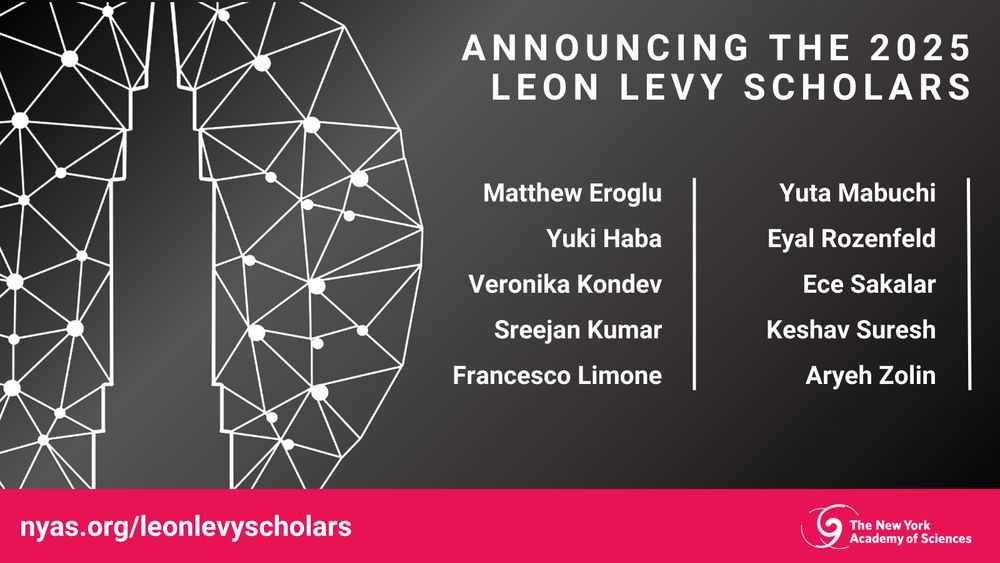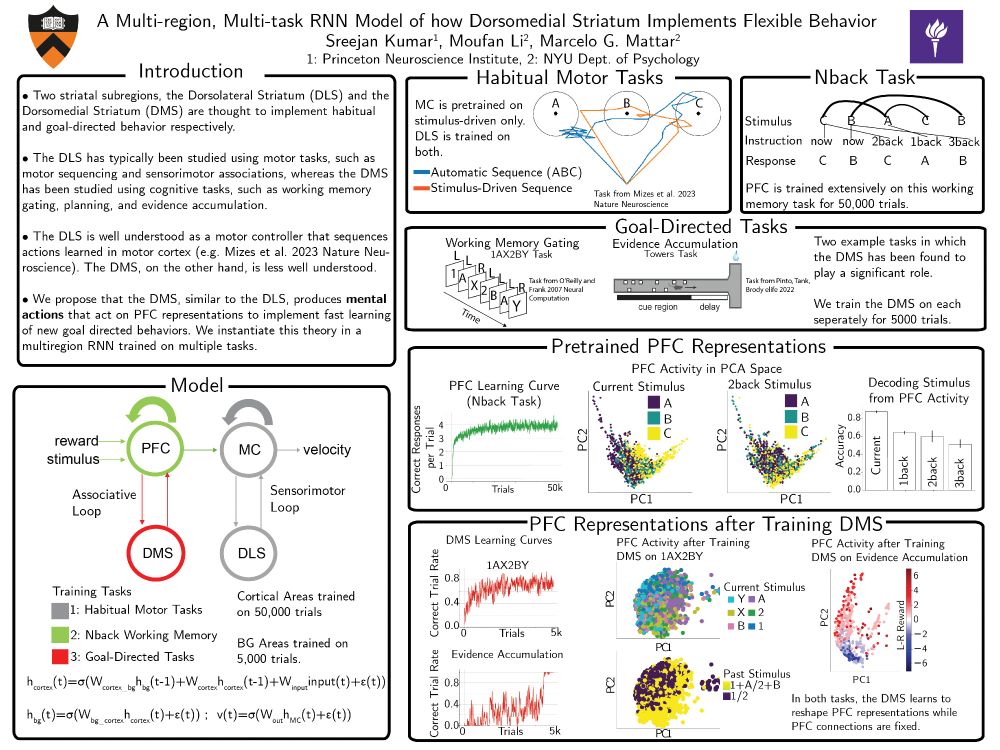

New in @pnas.org: doi.org/10.1073/pnas...
We study how humans explore a 61-state environment with a stochastic region that mimics a “noisy-TV.”
Results: Participants keep exploring the stochastic part even when it’s unhelpful, and novelty-seeking best explains this behavior.
#cogsci #neuroskyence
28.09.2025 11:07 — 👍 95 🔁 36 💬 0 📌 3
I’m super excited to finally put my recent work with @behrenstimb.bsky.social on bioRxiv, where we develop a new mechanistic theory of how PFC structures adaptive behaviour using attractor dynamics in space and time!
www.biorxiv.org/content/10.1...
24.09.2025 09:52 — 👍 213 🔁 85 💬 9 📌 9
At a surface level, you’d think these are contradictory, first work Shows DLS is stimulus-independent and second shows its stimulus-dependent. But our framework reconciles this
06.09.2025 16:15 — 👍 0 🔁 0 💬 1 📌 0
Yes, maybe I wasnt clear! On the first result, we explore work showing time encoding in DLS is unaffected by stimulus properties. In the second, we look at work showing the DLS is dependent on sensory stimuli to properly time and execute motor habit.
06.09.2025 16:15 — 👍 0 🔁 0 💬 1 📌 0
For your second questio, our settings focus on typical RL settings where there’s an observation, action, and then a reward.
06.09.2025 16:12 — 👍 1 🔁 0 💬 1 📌 0
Thanks for your interest! It wasnt a focus but technically our last task features a task where the model implements variable length chink, since its about getting to the goal in a prespecified amount of time and the goal time changes per trial
06.09.2025 16:12 — 👍 1 🔁 0 💬 1 📌 0

Alexander Mathis (@trackingskills.bsky.social)
Hacker, Computational Neuroscience, ML beyond logistic regression, bear and muscle spindle aficionado. Passionate about open source. #deeplabcut and see https://mathislab.org for more.
Thanks for reading! Special and huge thanks to my co-first author Mathieu Le Cauchois and senior authors @marcelomattar.bsky.social and Jonathon R. Howlett, as well as co-authors @trackingskills.bsky.social l and @leaduncker.bsky.social! The work wouldn't be possible without all of them.
06.09.2025 15:12 — 👍 3 🔁 0 💬 0 📌 0

Second, it's known that we build compressed abstractions of our environments that allow us to generalize. What's maybe not known is that this process is intrinsically tied to forming habits and complex action plans!
06.09.2025 14:35 — 👍 4 🔁 0 💬 2 📌 0


What are the implications? First, sensory compression is not just in DLS. It's also in other areas such as Hippocampus and Cerebellum. So we predict that wherever there is sensory compression happening, there is also time encoding and support of time-sensitive behaviors.
06.09.2025 14:35 — 👍 3 🔁 0 💬 1 📌 0
This is because sensory compression produces intrinsic, task-independent time encoding trajectories and these dynamics act as a scaffold to implement timing of task-specific behaviors where sensory stimuli guide the *progression* along these trajectories.
06.09.2025 14:35 — 👍 3 🔁 0 💬 1 📌 0

Second, it accounts for another result that shows something contradictory: the DLS actively uses sensory stimuli to time and execute motor habits.
06.09.2025 14:35 — 👍 3 🔁 0 💬 2 📌 0

We then show that this model accounts for seemingly paradoxical findings in time representations in the DLS. First, we show our model explains results that encoding of time in rat DLS is invariant to task relevancy and stimulus properties.
06.09.2025 14:35 — 👍 4 🔁 0 💬 1 📌 0

We then see that bottleneck models engage these stable neural trajectories that implicitly encode time by where you are in the trajectory.
06.09.2025 14:35 — 👍 3 🔁 0 💬 1 📌 0

We show that a model with a sensory bottleneck accounts for many behavioral effects that @gershbrain.bsky.social
and @lucylai.bsky.social
characterize in their work on human action chunking, whereas a non-bottleneck baseline does not.
06.09.2025 14:35 — 👍 4 🔁 0 💬 1 📌 0

To test our hypothesis on the effect of sensory compression on action chunking and time coding, we developed an RNN model with sensory bottlenecks and trained it on RL tasks that involve chunking.
06.09.2025 14:35 — 👍 3 🔁 0 💬 1 📌 0


The DLS is known to be a "bottleneck" in sensorimotor processing. Millions of cortical neurons project onto orders of magnitude fewer striatal cells, producing highly favorable conditions for compression.
06.09.2025 14:35 — 👍 4 🔁 0 💬 1 📌 0

If these functions are co-located, one might believe there's a common mechanism for them. Our work suggests that this mechanism is sensory compression!
06.09.2025 14:35 — 👍 3 🔁 0 💬 1 📌 0


What's another function the DLS is involved in? Time encoding! According to a review paper by Edvard and May-Britt Moser (2014 Nobel prize winners), the brain tracks time through "stable neural trajectories" where cell populations fire predictably along a trajectory.
06.09.2025 14:35 — 👍 4 🔁 0 💬 1 📌 0


A region of the brain that's a big driver of action chunking is the Dorsolateral Striatum (DLS)
06.09.2025 14:35 — 👍 4 🔁 0 💬 1 📌 0

A primary way this manifests in behavior is through action chunking, where predictable action sequences become compressed into cohesive, reusable units. Think of typing a familiar password, phone number, or playing a well-practiced song on an instrument.
06.09.2025 14:35 — 👍 3 🔁 0 💬 1 📌 0

Why do we brush our teeth without having to think about it? Our brain can learn habits through repetition. Habits become automatized in that, once they’re formed slowly over many repetitions, we can execute them automatically without having to “think” about them.
06.09.2025 14:35 — 👍 5 🔁 0 💬 1 📌 0
Note: I'm a co-author of centaur, but this is my personal opinion and not necessarily an "official" one
10.07.2025 15:16 — 👍 1 🔁 0 💬 0 📌 0
The fact that one of the very few (and unsatisfying) ways to do this is convert many experiments into one medium (language) and finetune an LLM raises the question of how our fields can do more *unifying* and less make an entirely new task -> collect new data -> make a model -> publish -> move on.
10.07.2025 15:12 — 👍 2 🔁 0 💬 2 📌 0
Centaur isn’t a good theory as it misses much of what @jeffreybowers.bsky.social .social highlights. But to me the attempt represents what theories should aspire to: a single model that can explain *multiple* experiments/paradigms. We certainly don't do this enough either in cogsci or neuro.
10.07.2025 15:09 — 👍 3 🔁 0 💬 1 📌 0
Congrats Fred!
08.05.2025 18:19 — 👍 2 🔁 0 💬 0 📌 0

Congratulations to all our Columbia scientists recognized with NYAS 2025 Leon Levy Scholarships in Neuroscience: Matthew Eroglu, @yukihaba.bsky.social , @sreejan.bsky.social , Yuta Mabuchi and Keshav Suresh.
👏👏👏
Read more about the Scholars: bit.nyas.org/3Yoa6Pf
29.04.2025 14:22 — 👍 12 🔁 2 💬 0 📌 3

See me at #COSYNE2025 poster session 2 if you want to learn more about this emerging work!
26.03.2025 19:30 — 👍 5 🔁 1 💬 1 📌 0
Associate Professor in Psychology at Columbia, PI of https://www.dpmlab.org/
Cognitive neuroscientist and AI researcher
Theoretical neuroscientist
Research fellow @ Kempner Institute, Harvard
dclark.io
Computational models of episodic memory
Postdoc with Daphna Shohamy & Stefano Fusi @ Columbia
PhD with Ken Norman & Uri Hasson @ Princeton
https://qihongl.github.io/
postdoc at nyu | (episodic) memory and decision making | jonathanicholas.github.io
studying cognitive dynamics and how the brain computes | postdoc-ing at WashU CTCN
https://hyssong.github.io/
Assistant professor at NYU.
Hacker, Computational Neuroscience, ML beyond logistic regression, bear and muscle spindle aficionado. Passionate about open source. #deeplabcut and see https://mathislab.org for more.
asst prof @Stanford linguistics | director of social interaction lab 🌱 | bluskies about computational cognitive science & language
Postdoc in the Bendesky lab at Columbia
Leon Levy Neuroscience Scholar, Alan Kanzer Postdoctoral Fellow, JSPS Research Fellow
PhD at Cornell NBB | Yapici lab
Wannabe baby mind reader. Also, I'm from New Zealand.
Lab website: https://soc.stanford.edu/
postdoc with Marcelo Mattar - https://carlos.correa.me/
Cognitive neuroscientist (Assistant Professor at NYU), human episodic memory, M/EEG, ECoG, and behavior. How do we reinstate temporally dynamic, information-rich memories?
comp neuro assistant prof at columbia
I study how people solve big problems with small brains. Starting at Dartmouth in 2026—I'm recruiting!
https://fredcallaway.com
Assistant professor at Cornell Psychology Department. CoCoCo Lab (Cornell Computational Cognition Lab) @co3lab.bsky.social. I am recruiting!
Computational neuroscientist at Imperial College. I like spikes and making science better (Neuromatch, Brian spiking neural network simulator, SNUFA annual workshop on spiking neurons).
🧪 https://neural-reckoning.org/
📷 https://adobe.ly/3On5B29























